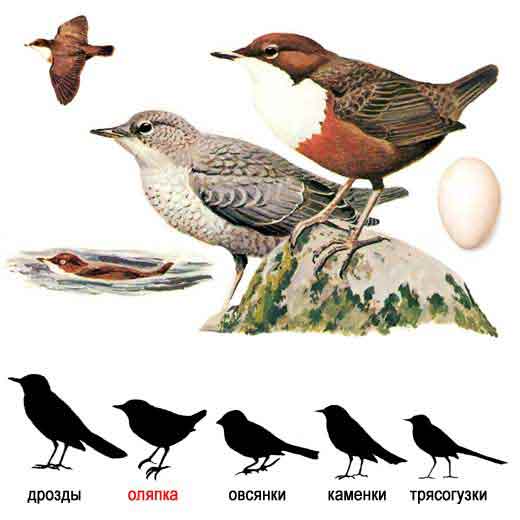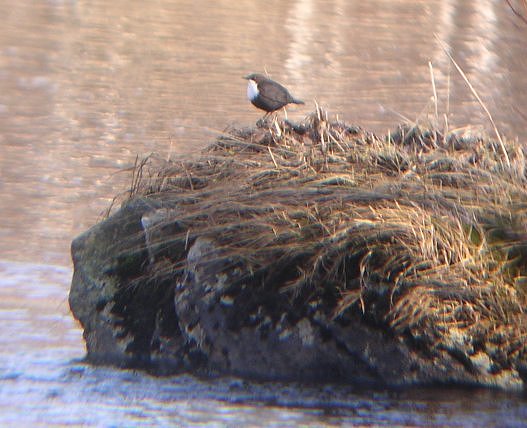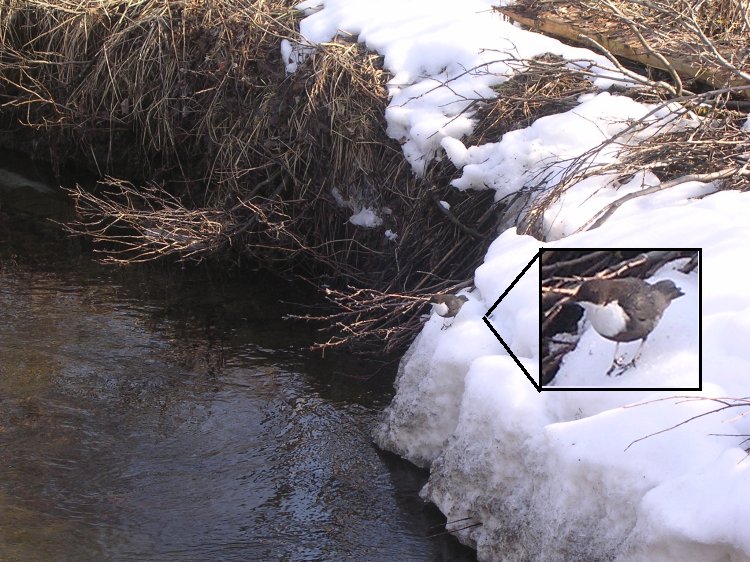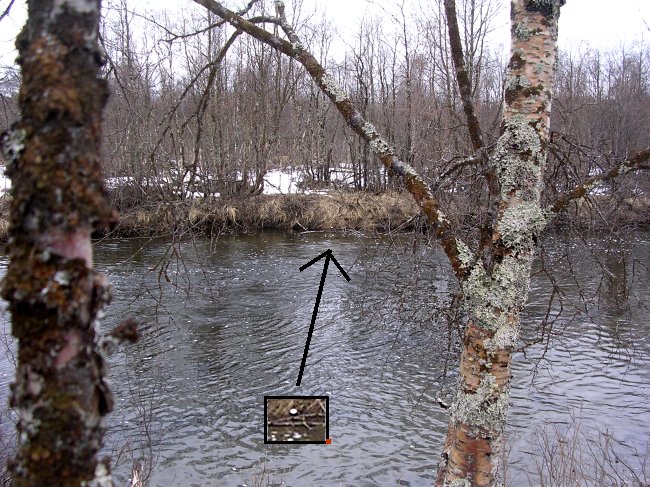Dippers are members of the genus Cinclus in the bird
family Cinclidae,
named for their bobbing or dipping movements. They are unique
among passerines for their ability to dive and swim underwater.
Dippers are small, stout, short-tailed, short-winged, strong-legged
birds. The different species are generally dark brown (sometimes
nearly
black), or brown and white in colour, apart from the Rufous-throated
Dipper which is brown with a reddish-brown throat patch.
Sizes range from 14–22 cm in length and 40-90 g in weight,
with males larger than females. Their short wings give them
a distinctive whirring flight. They have a characteristic bobbing
motion when perched beside the water, giving them their name.
Dippers are found in suitable freshwater habitats in the highlands
of the Americas, Europe and Asia. In Africa they are only found
in the
Atlas Mountains of Morocco. They inhabit the banks of fast-moving
upland rivers with cold, clear waters, though, outside the breeding
season, they may visit lake shores and sea coasts.
Unlike many water birds, dippers are generally similar in form
to many terrestrial birds (for example they do not have webbed
feet),
but they do have some morphological and physiological adaptations
to their aquatic habits. Their wings are relatively short but
strongly
muscled, enabling them to be used as flippers underwater. They
have dense plumage with a large preen gland for waterproofing
their
feathers. Relatively long legs and sharp claws enable them to
hold onto rocks in swift water. Their eyes have well-developed
focus
muscles that can change the curvature of the lens to enhance
underwater vision.They have nasal flaps to prevent water entering
their
nostrils. Their blood has a high haemoglobin concentration,
allowing a greater capacity to store oxygen than terrestrial
birds,
and allowing them to remain underwater for up to at least 30
seconds.
Source: http://en.wikipedia.org/wiki/Dipper |
| English |
Norsk |
Latin |
| White-throated Dipper |
Fossekall |
Cinclus
cinclus |
| Brown Dipper |
Brunfossekall |
Cinclus
pallasii |
| American Dipper |
Gråfossekall |
Cinclus
mexicanus |
| White-capped Dipper |
Andesfossekall |
Cinclus
leucocephalus |
| Rufous-throated Dipper |
Ruststrupefossekall |
Cinclus
schulzi |
White-throated
Dipper, Cinclus cinclus
 © http://www.ecosystema.ru/
Order: Passeriformes, Family: Cinclidae, Genus: Cinclus, Species:
Cinclus cinclus
© http://www.ecosystema.ru/
Order: Passeriformes, Family: Cinclidae, Genus: Cinclus, Species:
Cinclus cinclus
The White-throated Dipper, Cinclus cinclus, also known
as the European Dipper or just Dipper is an aquatic
passerine
bird found in Europe, Middle East, Central Asia and the Indian
Subcontinent. The species is divided into several subspecies,
based primarily on colour differences, particularly of the pectoral
band. The White-throated Dipper is Norway's national bird.
The White-throated Dipper is about 18 centimetres long, rotund
and short tailed. The head of the adult (gularis and
aquaticus) is brown, the back slate-grey mottled with black,
looking black from a distance, and the wings and tail are
brown. The throat and upper breast are white, followed by a
band of warm chestnut which merges into black on the
belly and flanks. The bill is almost black, the legs and irides
brown. Cinclus cinclus cinclus has a black belly band.
The young are greyish brown and have no chestnut band.
 Habitat.
Here from Troms in Northern Norway.
Habitat.
Here from Troms in Northern Norway.
Photo: © www.vulkaner.no |
The White-throated Dipper is closely associated with swiftly
running rivers and streams or the lakes into which these fall.
It often perches bobbing spasmodically with its short tail uplifted
on the rocks round which the water swirls and tumbles.
It acquired its name from these sudden dips, not from its diving
habit, though it dives as well as walks into the water.
It flies rapidly and straight, its short wings whirring swiftly
and without pauses or glides, calling a shrill zil, zil, zil.
It will then either drop on the water and dive or plunge in
with a small splash.
From a perch it will walk into the water and deliberately submerge,
but there is no truth in the assertion that it can defy the
laws of specific gravity and walk along the bottom. Undoubtedly
when entering the water it grips with its strong feet, but the
method of progression beneath the surface is by swimming, using
the wings effectively for flying under water. It holds itself
down by muscular exertion, with its head well down and its body
oblique, its course beneath the surface often revealed by
a line of rising bubbles.
 Looking
out over the river.
Looking
out over the river.
Photo: © www.vulkaner.no
|
In this way it secures its food, usually aquatic invertebrates
including caddis worms and other aquatic insect larvae, beetles,
Limnaea, Ancylus and other freshwater molluscs, and also small
fish. A favourite food is the small crustacean Gammarus,
an amphipod shrimp. It also walks and runs on the banks and
rocks seeking terrestrial invertebrates.
The winter habits of the Dipper vary considerably and apparently
individually. When the swift hill streams are frozen it is
forced to descend to the lowlands and even visit the coasts,
but some will remain if there is any open water.
 Watching
out for fish in the water. Not allways so easy to spot
in the snow.
Watching
out for fish in the water. Not allways so easy to spot
in the snow.
Photo:
© www.vulkaner.no |
The nest is by the water. It is large, globular or oval, like
a large Wren's nest, built into a crack or hollow in the rock,
in the masonry, or on the supports of a bridge, or, more rarely,
in an overhanging branch.
It is composed of moss, dead grass and leaves. This ball, however,
is just a shelter. Usually hidden beneath a lip, is the
entrance to the real nest within, a cup of grass or sedge, nearly
as large as the nest of a Blackbird, lined with leaves of oak,
beech or other trees. Three to six white eggs are laid starting
between March and May. One or two broods are reared,
usually in the same nest. When disturbed the young, when hardly
feathered, will at once drop into the water and dive.
 Its
much easier to take pictures of swans and geese.
Its
much easier to take pictures of swans and geese.
Photo:
© www.vulkaner.no |
|
|












